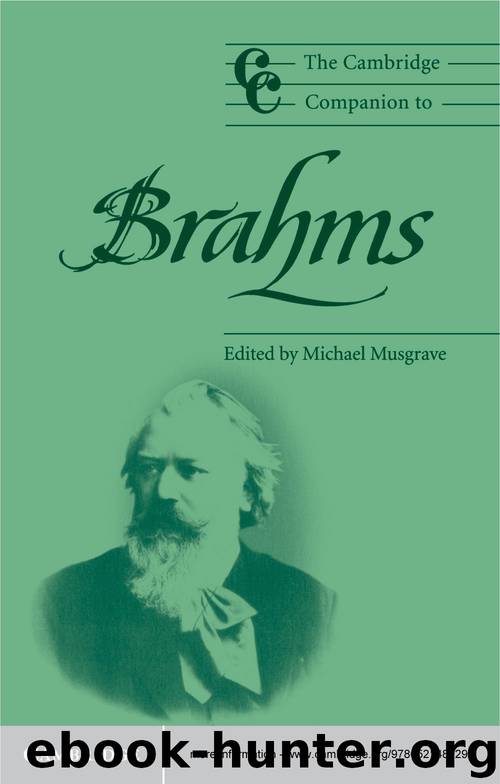The Cambridge Companion to Brahms (Cambridge Companions to Music) by The Cambridge Companion To Brahms (1999)

Author:The Cambridge Companion To Brahms (1999)
Language: eng
Format: epub
Publisher: Cambridge University Press
Published: 1999-05-27T04:00:00+00:00
Violin Concerto in D major Op. 77
Almost twenty years elapsed after the completion of this concerto before Brahms returned to the genre with a violin concerto of his own for Joachim: a task he might have been expected to fulfil much earlier, given his closeness to Joachim and the latter’s international eminence as a soloist. Perhaps, among many possible deterrents, he scrupled to spoil the Hungarian Concerto ’s chances to establish itself in the repertoire. By 1878 he probably felt he had waited long enough – and in the meantime had attained a complete command of the orchestra, demonstrated most recently in the two symphonies completed in 1876–7. The Violin Concerto evolved through the second half of 1878 in close consultation with Joachim, their collaboration continuing well into the following year, after the premiere, with extensive refinement of the solo part. Though Joachim’s role in this was vital, it was not always decisive for the final form of particular passages. 18
In this concerto too, though evolved over a much shorter period than the First Piano Concerto, Brahms made drastic modifications to his original design. Once again he had planned a work in four movements. Almost unprecedented in a violin concerto, this scheme would presumably have produced a work even larger than Joachim’s; but at a late stage Brahms decided to jettison his two middle movements – one of them a scherzo – in favour of the single slow movement we know (which he termed ‘a feeble Adagio’). As the four-movement Second Piano Concerto bears out, it is unlikely that even his original intention was to create a symphony-concerto hybrid. 19 Rather, that he felt the need (to which he surrendered in that work) for a large canvas with the optimum number of areas of contrast, provided by four rather than three well-defined musical characters. For over twenty-five years he had been accustomed to such formal resources in his concerted chamber music. Perhaps the prospect of undue length eventually deterred him, considering the slow progress which both his Piano Concerto and Joachim’s Hungarian Concerto had so far made in the world. None the less, the Violin Concerto certainly manifests affinities with Brahms’s Second Symphony of the previous year: they share the same key, and their first movements – in each case a large, unhurried Allegro non troppo in 3/4 time, romantic in instrumental colouring – evoke a similar sense of opulent and sometimes shadowed pastoral.
Here, however, the ‘symphonic’ elements are held in an ideal balance with (which means they give the impression of having been subordinated to) the demands of an eloquent violin part. It is, in fact, the weightiest and meatiest violin solo since – Joachim’s Hungarian Concerto .Yet the impression it creates is mercurial, voluble, rhapsodic: a sustained evocation of the effect of spontaneous improvisation, even though every phrase plays its role in a consummately planned symphonic scheme. Truly we may say of this concerto, as Brahms wrote to Clara Schumann: ‘It is a magnificent piece, of remarkable freedom
Download
This site does not store any files on its server. We only index and link to content provided by other sites. Please contact the content providers to delete copyright contents if any and email us, we'll remove relevant links or contents immediately.
The Goal (Off-Campus #4) by Elle Kennedy(13207)
Kathy Andrews Collection by Kathy Andrews(11340)
Diary of a Player by Brad Paisley(7270)
What Does This Button Do? by Bruce Dickinson(5936)
Assassin’s Fate by Robin Hobb(5863)
Big Little Lies by Liane Moriarty(5521)
Altered Sensations by David Pantalony(4872)
Pale Blue Dot by Carl Sagan(4628)
Sticky Fingers by Joe Hagan(3916)
The Death of the Heart by Elizabeth Bowen(3342)
The Heroin Diaries by Nikki Sixx(3326)
Beneath These Shadows by Meghan March(3154)
Confessions of a Video Vixen by Karrine Steffans(3104)
The Help by Kathryn Stockett(3023)
How Music Works by David Byrne(2968)
Jam by Jam (epub)(2881)
Harry Potter 4 - Harry Potter and The Goblet of Fire by J.K.Rowling(2814)
Strange Fascination: David Bowie: The Definitive Story by David Buckley(2702)
Petty: The Biography by Warren Zanes(2575)
